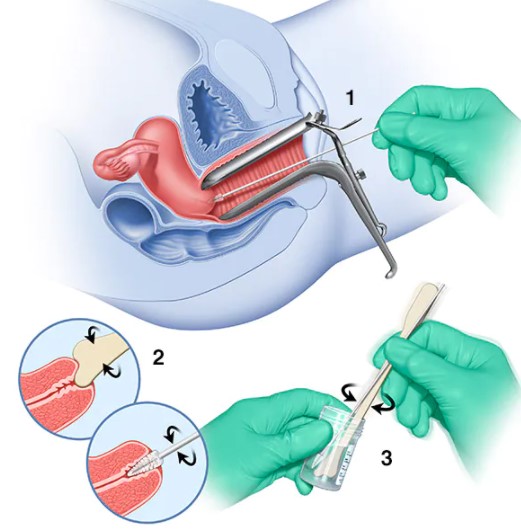Pap Test
A Pap Test involves collecting cells from your cervix — the lower, narrow end of your uterus that’s at the top of your vagina.
Detecting cervical cancer early with a Pap smear gives you a greater chance at a cure. A Pap smear can also detect changes in your cervical cells that suggest cancer may develop in the future. Detecting these abnormal cells early with a Pap smear is your first step in halting the possible development of cervical cancer.
The Pap Test is usually done in conjunction with a pelvic exam. In women older than age 30, the Pap test may be combined with a test for human papillomavirus (HPV) — a common sexually transmitted infection that can cause cervical cancer. In some cases, the HPV test may be done instead of a Pap smear.

In a Pap test, your doctor uses a vaginal speculum to hold your vaginal walls apart and to see the cervix. Next, a sample of cells from your cervix is collected using a small cone-shaped brush and a tiny plastic spatula (1 and 2). Your doctor then rinses the brush and spatula in a liquid-filled vial (3) and sends the vial to a laboratory for testing.
How often should a Pap smear be repeated?
Doctors generally recommend repeating Pap testing every three years for women ages 21 to 65. Women age 30 and older can consider Pap testing every five years if the procedure is combined with testing for HPV. Or they might consider HPV testing instead of the Pap test.
Do women who’ve received the HPV vaccine still need to have Pap tests?
Yes. The HPV vaccine isn’t intended to replace Pap tests.
At what age should the Pap Test be started ?
To detect cervical cancer in the earliest stages, see your doctor for regular Pap tests beginning at age 21. Seek prompt medical attention if you notice any signs or symptoms of cervical cancer — vaginal bleeding after sex, between periods or after menopause, pelvic pain, or pain during sex.
What can you do to protect yourself from cervical cancer if you’re not in the recommended vaccine age group?
HPV spreads through sexual contact — oral, vaginal or anal. To protect yourself from HPV, use a condom every time you have sex. In addition, don’t smoke. Smoking raises the risk of cervical cancer.
